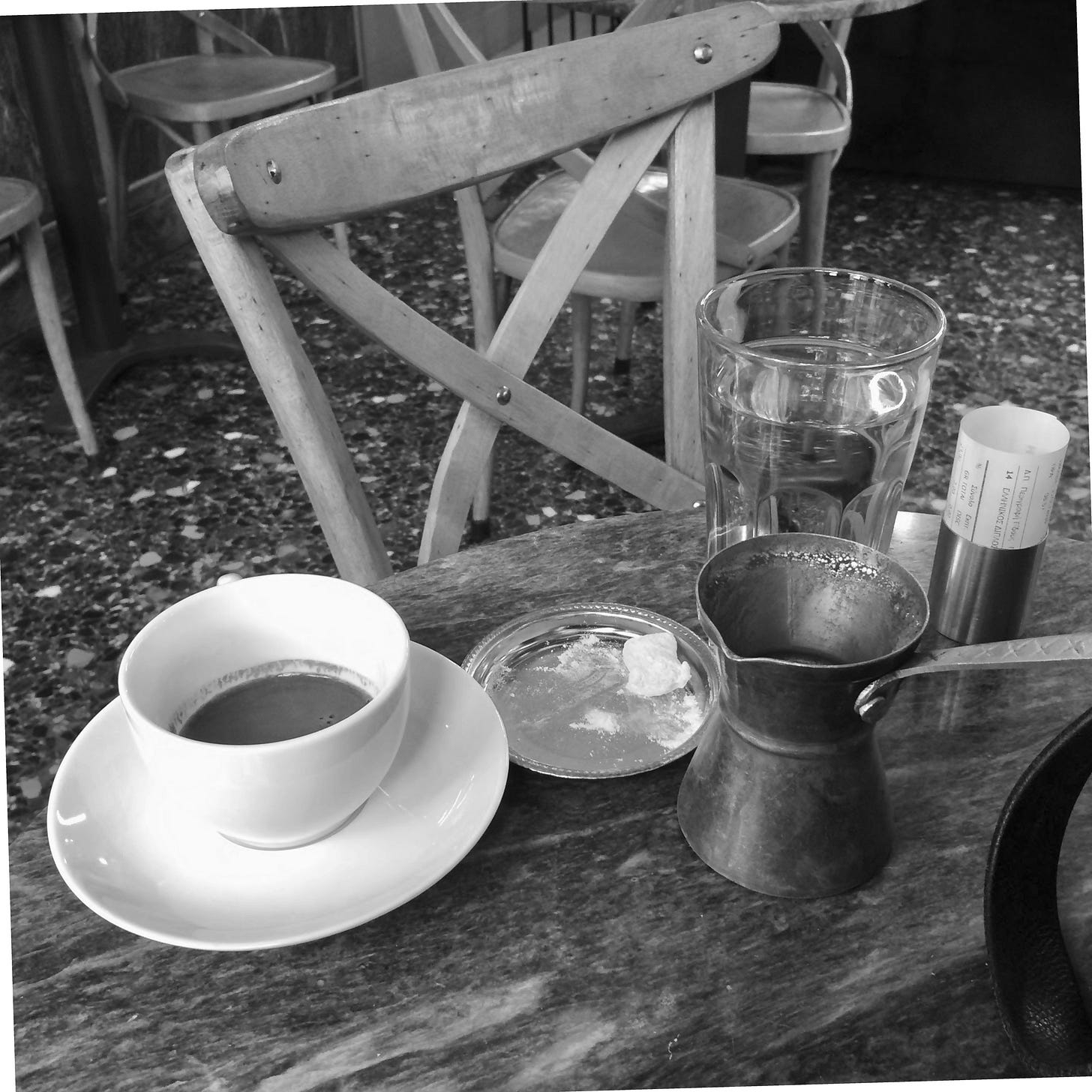Every culture has its own relationship with coffee. Italians race through their morning espresso standing up at the coffee bar, Americans top their bucket-sized to-go drinks with syrups and whipped cream, Austrians make coffee a ritual of consumption, each cup served with a ceremony of china and linen.
For Greeks coffee can last for hours, a cherished sacred time. Their leisurely approach complements the already existing characteristic of Greeks to congregate and talk about life, politics, culture, and their favorite football club. In fact when coffee shops, kafeneios, were first introduced to Greece during the Ottoman Empire they were often near the barbershop (a place of congregation and discussion that goes back to ancient Greece), marking the kafeneion's place as a male preserve. Gathering places can be disruptors--keeping people from their work and leaving space for ideas, argument, and discussion. Some of the Ottoman Empire's religious leaders tried outlaw coffee, and succeeded in some of Constantinople's Muslim neighborhoods. Likewise, in England, King Charles II closed the coffeehouses, stating they “have produced very evil and dangerous effects,” a “disturbance of the peace and quiet realm.” In both cases, the outcry was immediate, as was the loss of tax revenue. Ottoman authorities lifted the ban and coffee became a staple throughout the empire.
In the summer when I was 13 and still living in the working-class neighborhoods of west Patra, I felt that I was ready to embark on a paying job. Up to that point I had only helped out at my father's and uncle’s garage and machine shops. Near my home was a kafeneio and through a friend I found out they needed a helper. I gathered my courage and approached the owner, Mr. Vasilis, to ask for a job. He hired me on the spot, paying 40 drachmas a day (a bit less than a dollar).
Mr Vasilis was a coffee master. Well into his 70s, possibly 80s, Mr. Vasilis was a tranquil and calm personality. Initially, my job was to follow him around and watch him make the coffee. After two weeks of this, I was allowed to approach a long-handled brass briki to make coffee. Mr. Vasilis had a simple but organized set-up to meet with the rush-hour demand that occurred in the morning and late afternoon around 4-5pm. Being that it was a classic Kafeneio we only served coffee and other similar beverages, along with the occasional Ouzo accompanied by a cold meze (olives, cucumber and a tomato, when in season)
Mr. Vasilis did not serve frappes, which he found a perplexing outrage. Frappes, like American ice cream cones, were created at an exposition fair, this one in Thessaloniki in 1957. When the representative from Nescafe couldn't find hot water for his instant coffee, he shook the granules with ice and cold water. When I was working at the coffee shop, the younger generation wanted to differentiate themselves from their elders (and their peasant backgrounds). Frappes were new, modern, and “Waster”; and now, along with the Fredo, they are ubiquitous--available at every cafe, while it's hard to find a good Greek coffee.
Our kafeneio was no different than thousands of kafeneios throughout Greece. It was a place where men could congregate (by unspoken rule, kafeneios were not for women) a place to go for coffee, conversation and to escape home for a bit. But it was also a bit of a clubhouse. Our kafeneio attracted retirees and from what I could tell, mostly of a more conservative political faction. Other kafeneios attracted people according to social class, age, political affiliation, and even what soccer club they rooted for. I loved observing, watching the interactions of the old-timers. I enjoyed every second of working there and I learned a lot. But I never quite mastered the Greek coffee tray. I'd regularly tip over the cup and ruin the creamy kaïmaki top, the finish that distinguishes a good cup of coffee.
A lot of people lump Greek coffee together Turkish coffee and Arabic coffee. Though they are cousins, made in a similar way, there are distinct differences. The Turks tend to prefer a dark roast, which to me tastes almost burnt. It's good coffee, but too heavy for my taste. Arabs roast their coffee with cardamom, an acquired taste. Greeks on the other hand roast their coffee lighter--xanthos (blonde), which creates an aromatic flavor in what would otherwise be a heavy coffee.
In recent years and something I find promising there is a new interest in search of the classic Greek coffee shop that makes the coffee in the hovoli (heated Sand box).
Even though they are fading away in Greece, occasionally you can find that neighborhood Kafekopteion ( coffee roasters) where you can pick up a wonderful bag of freshly ground coffee along with your favorite confections.
The Greek Coffee experience has a lot to do with the experience of patiently making a freshly grounded, slow roasted coffee, immersed in a bead of hot sand. More importantly it represents a sacred time where a community can gather to talk about local, national, and international affairs, along with a whole lot of fanfare. This delicately subtle daily ritual means everything for Greece and is part of the definition of being Greek.




